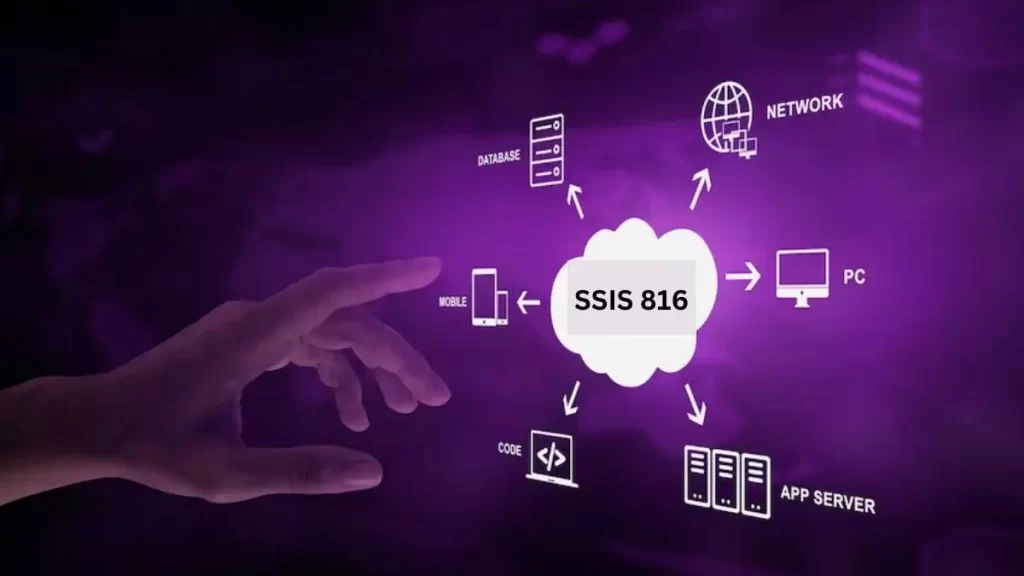SSIS 816: SQL Server Integration Services (SSIS) is a reliable tool to extract, transform as well as loading (ETL) data from a variety of sources into a single repository. If you’re a professional in the field of data and are familiar with the standard method of running SSIS packages on one server. With the release of SQL Server 2016, a new feature that is revolutionary was released called SSIS Scale Out also called SSIS 816. This groundbreaking feature changes the way we manage ETL processes, providing an efficient and scalable solution to high-volume data processing.
SSIS 816: An Overview
SSIS 816 represents a pivotal development with regards to the capability that are offered by SQL Server Integration Services. In the past, SSIS packages were executed on only one server which can become unwieldy when handling huge amounts of data. SSIS 816 solves this issue by introducing the notion of scaling out, which distributes the load of execution over several servers.
The principal goal the primary goal of SSIS 816 is to enhance the efficiency, throughput and resilience in ETL processes. With the help of multiple machines data professionals can greatly increase the efficiency of their workflows for data integration which will result in quicker and more reliable results.
The features of SSIS 816
1. Distributed Execution
The primary characteristic that is the main feature of SSIS 816 can be found in its capacity to spread SSIS’s execution SSIS packages across several servers. This method of distribution allows the processing of tasks in parallel which results in better performance for large-volume ETL operations.
2. Centralized Management
The execution is not dispersed, SSIS 816 provides a central management interface. Administrators can control, monitor and troubleshoot the whole SSIS Scale Out system from one central source of control. Centralized management makes it easier to manage the complexity of scale-out ETL processes.
3. Improved Fault Tolerance
SSIS 816 enhances the fault tolerance of ETL processes by decreasing the impact of server failures. In a typical single-server configuration the possibility of a server malfunction could cause disruption to an entire ETL process. But SSIS 816 is a different setup. SSIS 816 the load is distributed, which makes the system more tolerant to server malfunctions.
4. Increased Throughput
Its distributive nature SSIS 816 significantly improves the efficiency that is required for ETL processes. Processes that are traditionally performed sequentially on one server are now performed concurrently across multiple servers and result in quicker data integration.

The benefits of SSIS 816
1. Scalability
One of the main advantages that comes with SSIS 816 has to do with its ability to scale. Companies that deal with increasing volumes of data are able to easily scale up their IT infrastructures by adding additional servers into their SSIS Scale out configuration. This allows for scalability to ensure that ETL processes can handle the increasing workloads without affecting performance.
2. Optimization of Performance
Through the distribution of execution for SSIS applications, SSIS 816 optimizes performance for operations that require a lot of data. If you’re collecting data from various sources or transform the data into structured formats the processing capabilities that are parallel to SSIS 816 dramatically reduce the time needed to complete these kinds of tasks.
3. Resource Utilization
SSIS 816 lets you make more efficient efficiency of resource usage within the organisation. Instead of relying on one powerful server companies can make use of multiple machines each contributing to the total processing power. This method of distributed computing helps to maximize resource use and eliminates the development of bottlenecks.
4. Cost Efficiency
Alongside improved speed, SSIS 816 offers cost efficiency. Instead of spending money on a single, high-end server businesses can set up clusters of cheaper machines, dispersing the load and achieving the same or superior performance for less.
Modifications and Upgrades to SSIS 816
1. Support for SQL Server Versions
SSIS 816 is designed to seamlessly connect to SQL Server 2016 in addition to later versions. In order to benefit from the capabilities offered with SSIS Scale Out businesses should make sure they have their SQL Server installation is updated to the latest compatible versions.
2. Cluster Configuration
The process of setting up SSIS Scale Out requires configuring the cluster of machines to cooperate. The process of configuration has been simplified with SSIS 816, with enhanced tools and wizards that make it simpler to manage the process of setting up a scalable ETL environment.
3. Security Improvements
Security is an essential concern in any data-related environment. SSIS 816 provides security improvements in order to make sure that distributed execution SSIS software is not just efficient, but also secure. This includes strong encryption and authentication protocols.
Improvements and changes to SSIS 816
1. Monitoring and Improvements to Logging
SSIS 816 provides improvements to the monitoring and capability for logging. Administrators will gain greater insight into the operation of SSIS applications within the whole cluster. which will facilitate the identification of issues and their resolution.
2. Dynamic Scaling
One notable improvement of SSIS 816 is dynamic scaling which enables the system to adjust to shifting workloads in real-time. When the need for processing power changes, SSIS Scale Out can automatically adjust the amount of servers that are involved in the process, which ensures optimal utilization of resources.
3. Load Balancing
Load balancing is an essential component for any distributed network. SSIS 816 integrates sophisticated load balancing algorithms to ensure that tasks are distributed evenly among the servers within the cluster. This does not just increase throughput but also helps prevent the individual servers from being overwhelmed.
How do you upgrade to SSIS 816
1. Check Compatibility
Prior to upgrading to SSIS 816 it is essential to confirm that you are compatible with your current SQL Server environment. Make sure you’re operating SQL Server 2016 or a earlier version, because SSIS 816 isn’t retro-compatible with older SQL Server releases.
2. Backup and Restore
Like every upgrade, it’s vital to take a thorough backup of all your SSIS applications and databases. In the event of unexpected issues that arise during the process of upgrading, having a backup that is reliable will allow you to go back to the original state with no loss of data.
3. Installation SSIS Scale Remove Components
The process of upgrading involves the installation of the components needed required for SSIS Scale On on every server within the cluster. The wizard for installation guides administrators through the configuration and ensures a smooth implementation to the distributed ETL infrastructure.
4. Configure the Cluster
After the components have been installed After that, the next step is to set up to configure the SSIS Scale Out cluster. This is about setting the topology, including the roles for each server and setting up communications channels among the servers. The process of setting up the configuration has been improved to perfection in SSIS 816, with intuitive interfaces that simplify setting up.
5. Test and validate
Following the configuration and upgrade A thorough test is required following the upgrade and configuration. Perform SSIS applications across the cluster, observe performance, and then verify the results. This testing phase enables companies to determine and resolve any issues prior to installing SSIS 816 in a production environment.
FAQs
1. What exactly is SSIS 816 and what is its difference from the traditional SSIS?
The answer is SSIS 816 which is called SSIS Scale Out is a new feature with SQL Server 2016 that allows the spread of SSIS package execution across several servers. In contrast to the traditional SSIS that runs the packages on one server, SSIS 816 enhances efficiency, scalability and the ability to handle faults by using the power of a cluster of servers.
2. What are the main characteristics that are the most important features SSIS 816?
Answer: The most important advantages offered by SSIS 816 include distributed execution for parallel processing, central management to monitor and control improved reliability, fault tolerance and compatible with SQL Server versions 2016 and later, as well as security enhancements.
3. What are the benefits of SSIS 816 benefit organizations?
Solution: SSIS 816 provides scalability and optimizes performance for large-volume data operations. It increases the utilization of resources as well as enables cost efficiency and improves the degree of fault tolerance. Its distributed structure SSIS 816 lets you dynamically scale, intuitive load balance and centralized management, which guarantees reliability and efficiency ETL processes.
4. What are the modifications and upgrades SSIS 816 introduce?
The answer is SSIS 816 brings changes that improve connectivity with SQL Server Versions, simplified cluster configuration, and more security measures. Dynamic scaling and load-balancing are noteworthy improvements that provide flexibility to the changing demands of users and providing a fair distribution of tasks over servers.
5. What can companies do to upgrade their systems their systems to SSIS 816?
Answer For the upgrade process to SSIS 816 businesses must first determine for compatibility with your SQL Server environment, perform thorough backups, then add SSIS Scale out components onto every server within the cluster. The next step is configuring the cluster and testing the deployment thoroughly and confirming the results prior to moving to a production environment.
6. What are the benefits SSIS 816 bring in terms performance optimization?
Solution: SSIS 816 enhances efficiency by spreading its execution SSIS packages across several servers. This ability to process parallelly minimizes the time required to perform intensive operations that require data, like the extraction and transformation of data from a variety of sources.
7. What does SSIS 816 contribute to cost efficiency?
The answer is SSIS 816 contributes to efficiency in cost by allowing businesses to make use of a group of less expensive equipment instead of acquiring an expensive single server. This approach to distributed computing ensures equal or superior performance for less cost which makes it an affordable solution to handle large amounts of data.
8. What are the steps involved in setting up for the SSIS 816 cluster?
Answer How to configure SSIS 816’s cluster is as simple as setting up the SSIS 816 cluster involves checking compatibility, making backups as well as installation of SSIS Scale Out elements and configuring the cluster by setting up roles and topology, and setting up communications channels among servers. The process is simplified with SSIS 816, with intuitive interfaces to make setting up easier.
9. How can SSIS 816 provide security for the execution of packages distributed?
The answer is SSIS 816 brings security enhancements, which include strong authentication mechanisms as well as encryption protocols, which will assure that distributed execution SSIS applications isn’t just effective, but also secure.
10. Why should data professionals think about adopting SSIS 816 to improve the ETL processes?
The answer is that data professionals must look into using it to unlock a new level of efficiency in ETL processes. Benefits of increased performance, scalability and cost effectiveness place SSIS 816 to be a viable solution for businesses that are dealing with an ever-growing number of data sources and the requirement for real-time information.

To conclude
SQL Server Integration Services is long been an integral part of an arsenal for data specialists, offering solid ETL capabilities. With the launch of SSIS Scale Out which is embodied within SSIS 816, Microsoft has increased the efficiency as well as the scalability and reliability and scalability of SSIS to new levels. The ability to spread the execution of packages over multiple servers is not only enhancing the efficacy of ETL processes, but also allows it to be in tune with the requirements of the modern, data-intensive applications. www.crackle.com activate guide.
As businesses struggle to cope with the growing databases and the need for instantaneous insights, SSIS 816 emerges as an ideal solution. Benefits of increased performance, scalability and efficiency in cost position SSIS 816 as an essential resource for companies looking to make the most of the full capabilities of their infrastructure for data. To stay on top of the world of data management Data professionals are urged to investigate and adopt SSIS 816 which will open the new age of efficiency in the field of ETL.
Also Read: Best Security Measures to Protect Your Servers




